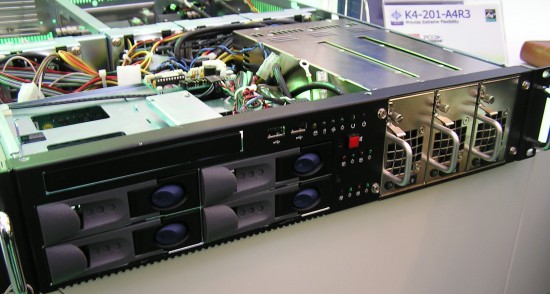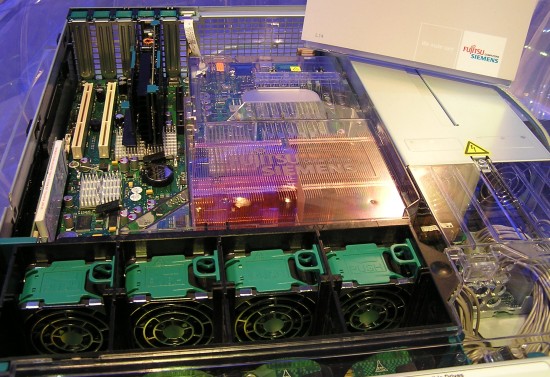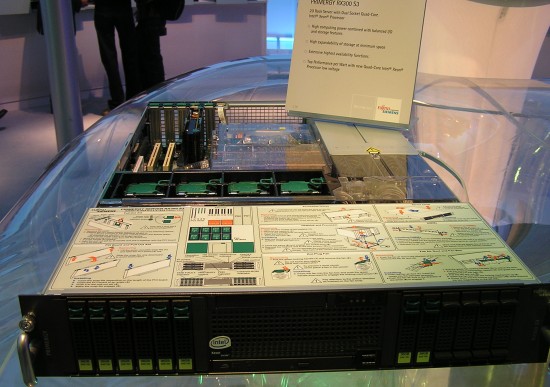CeBIT 2007: Storage & Servers
by Johan De Gelas on March 29, 2007 12:15 AM EST- Posted in
- Trade Shows
MSI
MSI was showing off their first quad socket server: the MSI K4-201-A4R3. The Socket-F based Opteron server with a hard to remember name has a 2+1 750W PSU. The server has plenty of expansion possibilities: two PCIe x16 slots (x8 electrically), one PCIe x8 slot, two PCI-X slots (100 MHz), and one PCI slot. The PSUs have been placed in the front of the server to make more room for all these PCI slots and the four CPU sockets on the motherboard. The server makes use of the NVIDIA nForce professional 3600 chipset.

The only thing missing is an internal SAS controller; the internal disk bays only support SATA. A positive is the fact that two USB ports are available on the front of the server.
Fujitsu Siemens
Is a tier one OEM still able to differentiate itself on the hardware aspects of a server? That was the question we asked the people of Fujitsu-Siemens. It is not that easy as x86 servers have become mostly industry standard servers which all use the same chipsets, memory configurations and disk subsystems. Still, there are some subtle differences. For example, the new Primergy RX300 S3 - one of the first servers to make use of the low voltage 50W quad core Xeons - has a very well thought out cooling system.

Three completely separate tunnels cool the (quad core) Xeon CPU, the PSUs and the I/O cards. This results in less noise, less power consumption, and better cooling. The Primergy server is also one of the few servers which actually supports hot-pluggable PCI slots.

Fujitsu Siemens was also very prominently present on Novell's site, demonstrating a "management console" for the Xen Hypervisor which is bundled in SUSE SLES 10. The demo showed how an Apache and Oracle workload was dynamically balanced on several virtual machines.
MSI was showing off their first quad socket server: the MSI K4-201-A4R3. The Socket-F based Opteron server with a hard to remember name has a 2+1 750W PSU. The server has plenty of expansion possibilities: two PCIe x16 slots (x8 electrically), one PCIe x8 slot, two PCI-X slots (100 MHz), and one PCI slot. The PSUs have been placed in the front of the server to make more room for all these PCI slots and the four CPU sockets on the motherboard. The server makes use of the NVIDIA nForce professional 3600 chipset.

The only thing missing is an internal SAS controller; the internal disk bays only support SATA. A positive is the fact that two USB ports are available on the front of the server.
Fujitsu Siemens
Is a tier one OEM still able to differentiate itself on the hardware aspects of a server? That was the question we asked the people of Fujitsu-Siemens. It is not that easy as x86 servers have become mostly industry standard servers which all use the same chipsets, memory configurations and disk subsystems. Still, there are some subtle differences. For example, the new Primergy RX300 S3 - one of the first servers to make use of the low voltage 50W quad core Xeons - has a very well thought out cooling system.

Three completely separate tunnels cool the (quad core) Xeon CPU, the PSUs and the I/O cards. This results in less noise, less power consumption, and better cooling. The Primergy server is also one of the few servers which actually supports hot-pluggable PCI slots.

Fujitsu Siemens was also very prominently present on Novell's site, demonstrating a "management console" for the Xen Hypervisor which is bundled in SUSE SLES 10. The demo showed how an Apache and Oracle workload was dynamically balanced on several virtual machines.










13 Comments
View All Comments
BikeDude - Tuesday, April 10, 2007 - link
I've tried to use SuperMicro's management software in the past and quite frankly it is pure and utter c---.Last week I tried HP's management software, and could install the entire OS from a remote location. I could map a .iso image to the blade in question and it booted right up.
OTOH, as I recall, SuperMicro's remote desktop solution is based on VNC. Where HP lets you remotely access the console from before POST is even run, SuperMicro forces you to first install the OS.
(We have lots of Tyan and SuperMicro servers, but of course we might've missed something fundamental along the way -- but... HP has a very nice package once the hardware has been hooked up to the power outlet and your network switch)
Xenoterranos - Friday, March 30, 2007 - link
"Enermax showed how much hardware its Galaxy 1000W can power. According to Enermax, the PSU delivered 933 W to 24 80GB hard disks, four Opteron 8212 CPUs, four 3Ware 9650 drive controllers, a GeForce 7600GX and 8GB of RAM (16 x 512MB)."...or 2 GeForce 8800's.
yyrkoon - Friday, March 30, 2007 - link
So now we 'need' usb ports on the front of a rack mount server ?! I'd rather have onboard SAS to be honest ;)
Interresting toys, no doubt.
JohanAnandtech - Friday, March 30, 2007 - link
Well, I find sometimes very handy for installing quickly a driver or a small testprogram etc. Or in some cases to add a USB CDROM, or to make a quick backup on a USB harddisk.Do you feel that USB has no use on the front of a server?
neogodless - Thursday, March 29, 2007 - link
I've heard of Home Theatre PC (HTPC) but HPC... is...?laok - Thursday, March 29, 2007 - link
High Performance ComputingDesslok - Thursday, March 29, 2007 - link
Tyan should have taken the silica bag off that system before showing it off.AnandThenMan - Thursday, March 29, 2007 - link
Hellz no! The silica bag and the inanimate carbon rod are the main reasons people flock to these shows.ravedave - Thursday, March 29, 2007 - link
So the Barcelona is no longer known as the K8L and is now again being called the K10? When is the launch for this part? Last I saw it was Q1, which is almost over...JohanAnandtech - Thursday, March 29, 2007 - link
AFAIK, the K8L name was never used by AMD: it was invented on the Internet. THe K10 will be launched mid 2007 (that is all AMD says), probably the Summer of 2007